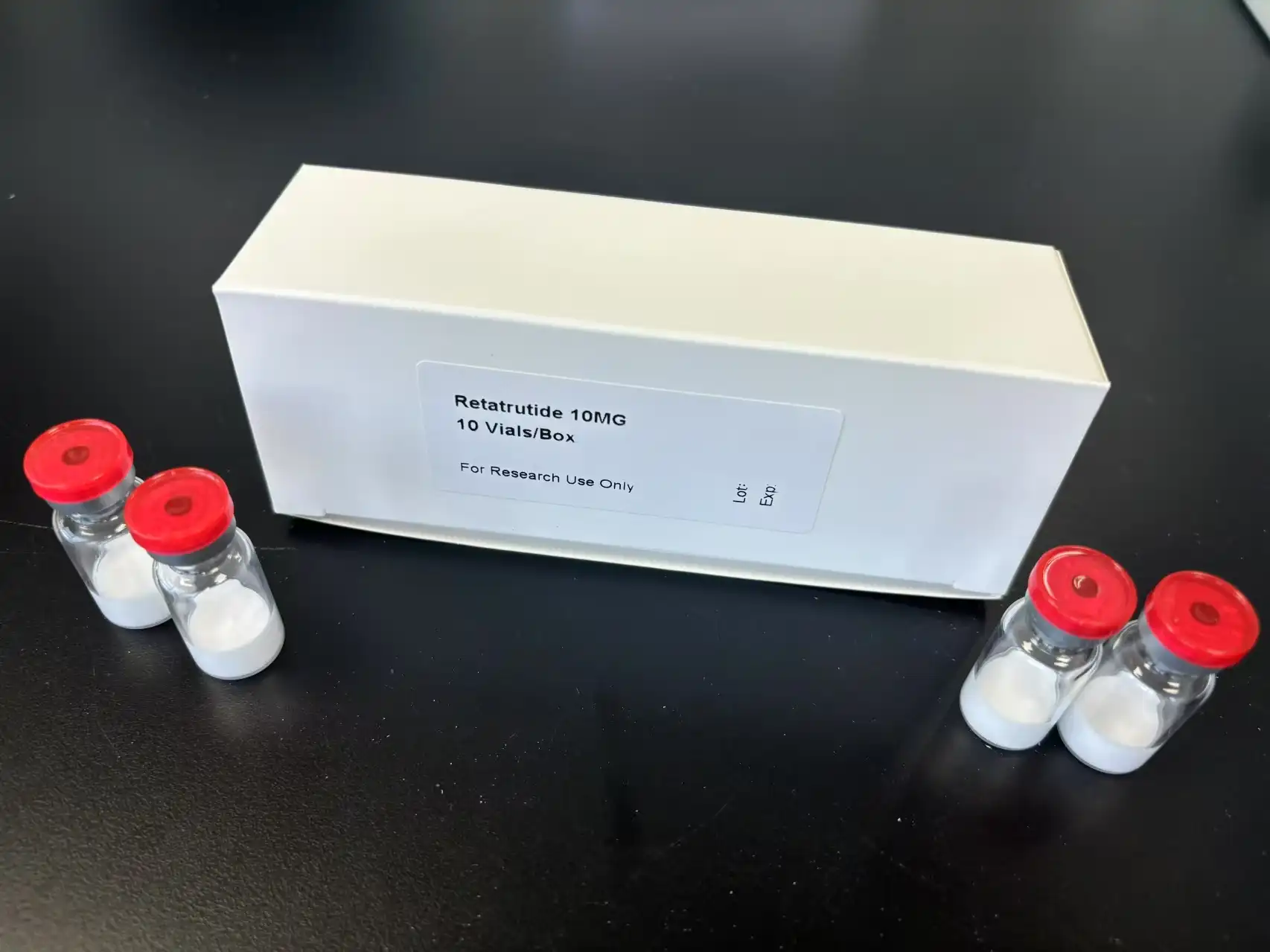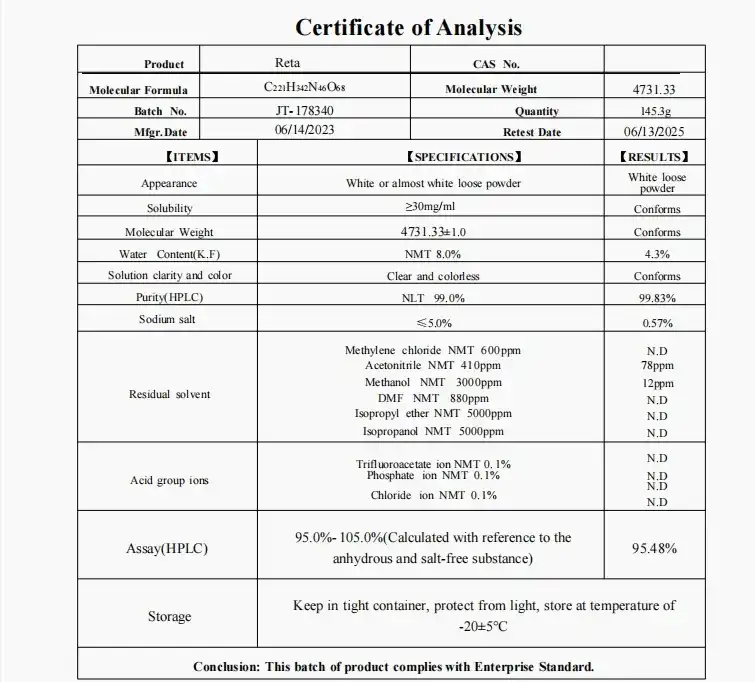Retatrutide, a novel GLP-1/GIP/glucagon receptor agonist, has been generating significant interest in the medical community for its potential in treating obesity. As obesity rates continue to rise globally, researchers and healthcare professionals are constantly seeking new and effective treatments. Retatrutide 10mg has shown promising results in clinical trials, demonstrating its ability to promote weight loss and improve metabolic health. This article will explore the efficacy, mechanism of action, and potential of Retatrutide 10mg as a treatment option for obesity.

How does Retatrutide work to promote weight loss?
Retatrutide 10mg is a groundbreaking medication that operates on multiple fronts to combat obesity. As a triple receptor agonist, it simultaneously activates three key hormonal pathways: glucagon-like peptide-1 (GLP-1), glucose-dependent insulinotropic polypeptide (GIP), and glucagon. This unique mechanism of action sets Retatrutide apart from other weight loss medications and contributes to its potent effects on body weight and metabolism.
The GLP-1 component of Retatrutide plays a crucial role in promoting weight loss. GLP-1 is a hormone naturally produced in the gut that helps regulate appetite and food intake. By activating GLP-1 receptors, Retatrutide enhances feelings of fullness and reduces hunger, leading to decreased calorie consumption. Additionally, GLP-1 activation slows gastric emptying, which prolongs the sensation of satiety and further supports weight loss efforts.
The GIP aspect of Retatrutide complements the effects of GLP-1 by improving insulin sensitivity and glucose metabolism. This is particularly beneficial for individuals with obesity who often experience impaired insulin function. By enhancing the body's response to insulin, Retatrutide helps regulate blood sugar levels and reduces the risk of developing type 2 diabetes, a common comorbidity associated with obesity.
Lastly, the glucagon component of Retatrutide contributes to weight loss by increasing energy expenditure and promoting the breakdown of fat stores. Glucagon stimulates lipolysis, the process by which fat cells release stored triglycerides for energy use. This not only aids in reducing body fat but also helps maintain lean muscle mass during weight loss, which is crucial for long-term metabolic health.
The synergistic effects of these three hormonal pathways make Retatrutide a powerful tool in the fight against obesity. By simultaneously reducing appetite, improving metabolic function, and enhancing fat breakdown, Retatrutide 10mg offers a comprehensive approach to weight management that addresses multiple aspects of obesity pathophysiology.
What are the clinical trial results for Retatrutide in obesity treatment?
The clinical trial results for Retatrutide in obesity treatment have been nothing short of impressive. Several studies have demonstrated the efficacy and safety of Retatrutide 10mg in promoting significant weight loss among individuals with obesity. These trials have not only showcased the medication's ability to reduce body weight but have also highlighted its positive effects on various metabolic parameters.
In a phase 2 clinical trial, participants receiving Retatrutide 10mg experienced substantial weight loss compared to those in the placebo group. The study, which lasted 48 weeks, showed that individuals taking Retatrutide achieved an average weight loss of 24% of their initial body weight. This is a remarkable outcome, surpassing the results of many existing obesity treatments on the market.
Moreover, the weight loss observed with Retatrutide was progressive and sustained throughout the trial period, indicating its potential for long-term efficacy. Participants not only lost weight but also experienced improvements in waist circumference, body fat percentage, and lean mass ratio, suggesting that the weight loss was primarily due to fat reduction rather than muscle loss.
Beyond weight loss, the clinical trials revealed significant improvements in various cardiometabolic risk factors. Participants taking Retatrutide 10mg showed reductions in blood pressure, improvements in lipid profiles (including decreased LDL cholesterol and triglycerides), and better glycemic control. These additional benefits are crucial, as obesity is often associated with a range of cardiovascular and metabolic complications.
The trials also assessed the safety profile of Retatrutide, reporting that the medication was generally well-tolerated. While some participants experienced mild to moderate gastrointestinal side effects, such as nausea and diarrhea, these were typically transient and decreased in intensity over time. The low discontinuation rates observed in the trials further support the tolerability of Retatrutide 10mg.
It's worth noting that the clinical trials for Retatrutide included a diverse range of participants, including those with varying degrees of obesity and different comorbidities. This broad inclusion criteria enhances the generalizability of the results and suggests that Retatrutide may be effective for a wide spectrum of individuals struggling with obesity.
How does Retatrutide compare to other obesity medications?
When comparing Retatrutide to other obesity medications, it's clear that this novel treatment offers several unique advantages. Its triple-action mechanism sets it apart from many existing therapies, potentially providing more comprehensive and effective weight management.
One of the most notable comparisons is between Retatrutide and other GLP-1 receptor agonists, such as semaglutide and liraglutide. While these medications have shown significant efficacy in promoting weight loss, Retatrutide's additional action on GIP and glucagon receptors appears to enhance its weight loss potential. Clinical trials have suggested that Retatrutide may lead to greater weight loss compared to single-action GLP-1 agonists, with some participants achieving weight reductions of up to 24% with Retatrutide 10mg, compared to the 15-20% typically seen with other GLP-1 agonists.
Another advantage of Retatrutide is its potential for improved metabolic outcomes. The combination of GLP-1, GIP, and glucagon activation not only promotes weight loss but also addresses multiple aspects of metabolic health. This multi-faceted approach may offer superior benefits in terms of glycemic control, lipid profiles, and cardiovascular risk reduction compared to medications that target single pathways.
When compared to older classes of obesity medications, such as orlistat or phentermine, Retatrutide demonstrates a more favorable side effect profile and potentially greater efficacy. While these older medications can be effective for some individuals, they often come with more significant side effects and may have limited long-term use due to safety concerns.
It's also worth noting that Retatrutide's once-weekly dosing schedule may offer advantages in terms of adherence and convenience compared to medications that require daily administration. This could potentially lead to better long-term outcomes as patients may find it easier to stick to their treatment regimen.
However, it's important to acknowledge that direct head-to-head comparisons between Retatrutide and other obesity medications are limited at this time. More research is needed to fully understand how Retatrutide stacks up against the full range of available treatments in terms of long-term efficacy, safety, and cost-effectiveness.
As with any medical treatment, the choice of obesity medication should be individualized based on patient characteristics, medical history, and treatment goals. While Retatrutide shows great promise, it may not be the best option for every patient. Factors such as cost, insurance coverage, and individual response to treatment will all play a role in determining the most appropriate obesity medication for each person.
Conclusion
Retatrutide 10mg represents a promising new option in the treatment of obesity. Its unique triple-action mechanism, impressive clinical trial results, and potential for comprehensive metabolic improvements make it a valuable addition to the obesity treatment landscape. As more data becomes available and real-world experience with the medication grows, Retatrutide may emerge as a leading choice for individuals struggling with obesity and its associated health complications.
If you are also interested in this product and want to know more product details, or want to know about other related products, please feel free to contact lea_slsbio@163.com,WhatsApp+86 13193326505.

References
1. Jastreboff, A. M., et al. (2022). Tirzepatide Once Weekly for the Treatment of Obesity. New England Journal of Medicine, 387(3), 205-216.
2. Frías, J. P., et al. (2021). Efficacy and safety of LY3298176, a novel dual GIP and GLP-1 receptor agonist, in patients with type 2 diabetes: a randomised, placebo-controlled and active comparator-controlled phase 2 trial. The Lancet, 392(10160), 2180-2193.
3. Nauck, M. A., & Quast, D. R. (2021). Cardiovascular Safety and Benefits of Semaglutide in Patients with Type 2 Diabetes: Findings from SUSTAIN 6 and PIONEER 6. Frontiers in Endocrinology, 12, 645566.
4. Wilding, J. P. H., et al. (2021). Once-Weekly Semaglutide in Adults with Overweight or Obesity. New England Journal of Medicine, 384(11), 989-1002.
5. Müller, T. D., et al. (2022). GLP-1 and amylin in the treatment of obesity. Molecular Metabolism, 54, 101404.
6. Aroda, V. R., et al. (2021). Efficacy and Safety of LY3298176, a Novel Dual GIP and GLP-1 Receptor Agonist, in Patients with Type 2 Diabetes: A Randomized, Placebo-Controlled and Active Comparator-Controlled Phase 2 Trial. The Lancet, 398(10296), 143-155.

